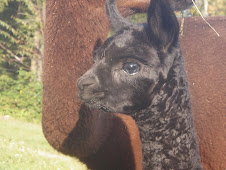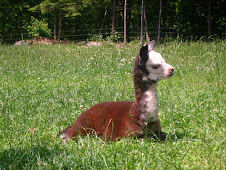Wednesday, March 2, 2011
Controlling Alpaca Parasites Naturally
A Whole Farm/Organic Approach to Parasite Management
Internal parasites are a part of most every livestock producer’s farm. Regardless of whether they are pasture raised or in a confinement setting, livestock will be exposed to internal parasites at some time in their life. In the Northeast, and in other humid climates, parasites can be a major problem and small ruminants, including alpacas, are more likely to have major disease problems with internal parasites than larger ruminants such as cattle.
So why adopt an organic approach to parasite management? Chemical dewormers are losing their effectiveness, with parasites developing resistance to them at an alarming rate. There are some parts of the country where internal parasites have developed resistance to all commercially available dewormers without new ones being developed. In our area where Meningeal worm is a threat and there is widespread use of Ivermectin, parasites that were formerly managed with this drug have grown resistant to it. Resistance means that not all the worms are killed during deworming. The surviving worms pass that genetic resistance on to offspring.
The growing concern about the resistance of internal parasites to all classes of dewormers has caused people to look for alternatives. By looking at the whole farm as an interrelated system, it becomes apparent that there are parts of the system that can be managed to decrease internal parasites and their effects. This management strategy not only postpones the day when chemical dewormers no longer work, but it also increases the overall health of the animal and future herd and it may even decrease costs.
It All Starts with Prevention and Management:
1. Healthy, properly conditioned animals – Parasites do not usually cause much harm to a healthy, well-nourished animal. Nutrition plays a major role in how well alpacas are able to overcome the effects of internal parasites. Quality feed, fresh water, minerals, managing stress and monitoring for condition are essential. Check weights/body score and mucus membranes regularly to monitor condition.
2. Stocking Density - By maintaining a healthy stocking density you decrease the overall infectivity rate of the farm. It also allows you to have more areas (pastures, etc) that you can rest for longer, creating more ‘clean’ areas. To calculate the optimum stocking density you’ll find a good worksheet at www.sarahflackconsulting.com
3. Quarantine – When an animal comes or returns to the farm keep it with a buddy in a quarantine area for one month while monitoring their health and doing regular fecals. This can protect your herd (particularly the geriatric, cria, weak or pregnant/lactating females) from parasites overloads and other disease to which they have not previously been exposed.
4. Pasture Rotation - There could be an entire article alone on this subject. Narrowing it down to two subjects there is rotation for the health of the grasses and soils and rotation to beat the lifecycle of parasites.
A. Lifecycle of parasites –If we begin with an understanding of the interrealtionship between the animal, the planst it Although some parasite eggs can live in the soils year round without a host, many of the parasites we are dealing with go through a 21 day lifecycle outside the host. The infected manure is dropped, three days later the eggs hatch into larvae searching for a host (the alpaca) and most die by 21 days if a host does not ingest them. We can take a simplistic view of this by considering wildlife where parasite loads generally do not cause disease and death in the host because, instinctively, wildlife are on the move. The parasites, therefore, have no host if the animal is no longer where the manure (eggs/occists) were dropped. The same principle applies to livestock. If we rotate our animals every 2-3 days to new pastures and not put them back on that same pasture for a minimum of 21 days we are significantly decreasing the numbers of larvae available to be ingested. Ideally, you want to size your pastures so that they eat it down to 2” in 3 days or even better 12-24 hours as most larvae live in the bottom 1-2” of grass.
B. Health of Grasses and Soils - Overgrazing of pastures
5. Cleanliness – we keep clean barns and pastures. We scoop manure twice daily and pile it in the current active compost pile. Scooping this often keeps the alpacas from stepping in it and dragging it all over and ingesting eggs or larvae. Actively composting your manure by creating the proper carbon/nitrogen mix will heat up the manure to 135 degrees and kill pathogens.
6. Encouraging Hardiness – our alpacas live most of their year out in the elements even though provided shelter year round. The winter barn faces south and is built into the hill providing shelter from winter wind while offering the warmth and health benefits of the sun. They have outside as well as inside hay feeders but mostly prefer to be outside. They live out on pasture in the summer months with areas of shade and a run-in shelter. They give birth in the pasture, sleep out under the stars and only take cover during a heavy rain. This encourages them to
7 Selective Breeding - Select for parasite resilient trait. By monitoring our animals we can most often detect which animals almost never shed eggs, those that do sometimes and those that always do. Obviously we would not want to perpetuate the animals that are easily infested as they will take down the health of the entire herd by shedding more eggs that our other alpacas can pick up.
Then moves to monitoring and treatment . . .
• In house fecals – we began doing these about ten months ago and believe it is one of our greatest tools to monitor alpaca health (along with body scoring/weighing and daily observation) and alpaca parasite resilience. We do a fecal on each alpaca when we do monthly herd health and we do them in between as necessary.
• Close observation of an animal in question –
• Strategic Deworming – treat the individual animal not the whole herd. This encourages the alpacas that do not have a parasite issue to continue to be resilient. Proper dosing is equally important because if you do not knock out the parasite but only knock it down then you are encouraging it to adapt to the drug, that is, develop resistance to it.
Please note: The information shared in this article should be approved by your veterinarian before being utilized in any way on any individual farm.
Our approach:
We are working toward an organic approach to parasite management for the benefit of our individual animals and for the greater good of the herd. In many areas of the country alpaca owners and breeders are experiencing parasite resistance to many of the drugs available and not many new ones are being developed. In New England we are looking at possibly another 3-5 years before the drugs don’t work here. Continual use and the incorrect use of chemicals as the method of parasite management results in parasites that become resistant to those very drugs. Then when we need them they no longer work. This is already seen with Ivomec due to the widespread use of it to control Meningial Worm. It no longer knocks out many of the parasites it used to.
For this reason, we take a multi-faceted approach to parasite management to limit the use of chemicals while working toward an organic approach. It may seem overwhelming but organic livestock raised for human consumption are doing it and even the non-organic livestock has withdrawal periods which cost farmers time and money.
Subscribe to:
Comments (Atom)








